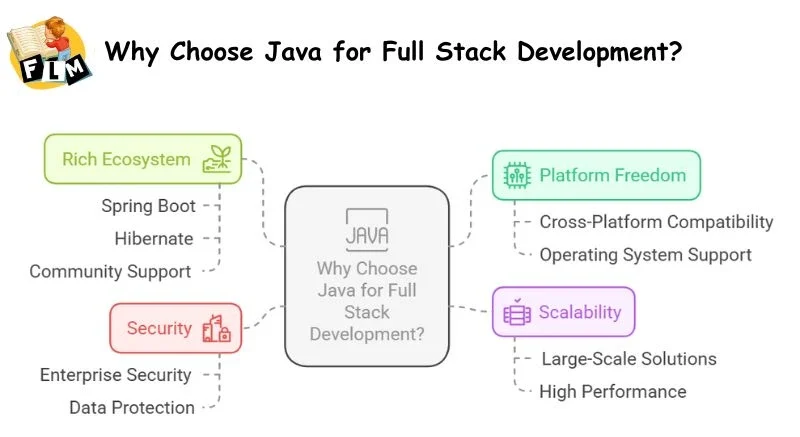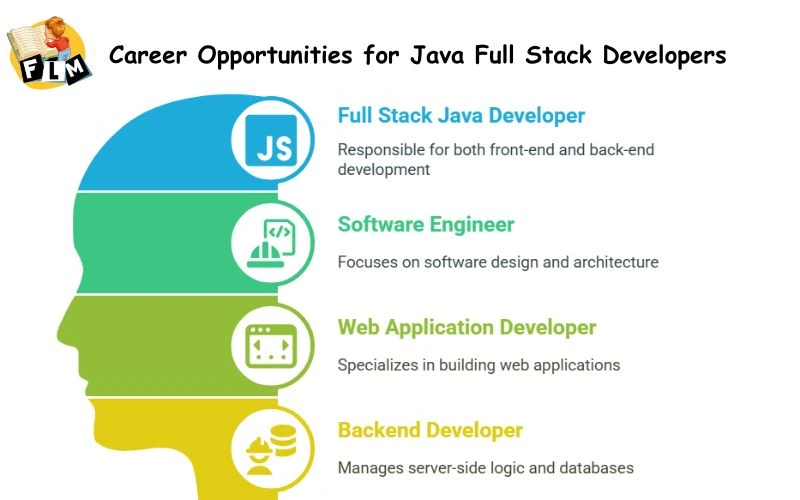The Java Full Stack Development includes the creation of both the front and backend of the web application using Java Technologies. The Java Full Stack Overview includes frontend technologies such as HTML, CSS, JavaScript, and Reacts or Angular Framework. Backend is powered by Java, Spring Boot, Hibernate and Restful API. Database data such as MySQL, PostgreSQL, or MongoDB handle data storage. DevOps such as GIT, Docker, and AWS support the deployment and scalability. It is necessary to create safe, scalable and high-performance applications.
What is Java Full Stack Development?
Java Full Stack Development refers to the ability to develop both front-end and back-end applications using Java Technologies. A Full-Stack Developer is skilled in working with database, server, system engineering and client-side development. To Build Complete Applications in this role requires knowledge of many Programming Languages, Structures and Tools.
Why Choose Java for Full Stack Development?

Java is one of the most widely used programming languages for full-stack development due to its:
- Platform Freedom: Java runs on many operating systems.
- Scalability: Suitable for building large-scale applications.
- Security: Strong security facilities make it ideal for enterprise applications.
- Rich Ecosystem: large community support and numerous frameworks.
Java’s extensive library and framework, such as Spring Boot and Hibernate, make it a preferred option for full-stack development. Additionally, Java is known for its backward compatibility, which ensures long-term stability and maintenance to enterprise applications.
Key Components of Java Full Stack Development
A Java Full Stack Developer works with various technologies categorized into three main layers:
Front-End Development (Client Side)
The Front-end development includes creating a visual interface of an application. It focuses on designing the user-friendly and interactive web pages. Major technologies used include:
- HTML, CSS, JavaScript: Basic building blocks for web design.
- React.js or Angular: Popular frameworks for building dynamic web applications.
- Bootstrap and Material UI: Library for Responsible Design.
- Typescript: A superstate of JavaScript that helps in writing scalable applications.
- Restful API integration: Fetching and displaying dynamic data from the backend.
A front-end developer ensures that the UI/UX design is intuitive and works basically in devices. Role involves understanding the user needs and making the application visually attractive.
Back-End Development (Server Side)
Back-end business logic, database operations and users are responsible for handling authentication. Java is Primary Language, supported by:
- Spring Boot: A powerful framework to create Rest API and Microservices.
- Java Servlets and JSP: Older Technologies are still used in some applications.
- Hibernate: ORM tool for managing database connections.
- Spring Security: Used for authentication and authority in web applications.
- Microservices Architecture: Breaking applications in small, managed services for better scalability and maintenance.
Java back-end development includes writing clean, skilled and maintainable codes that interact with Database, third-party API and other services.
Database Management
A full-stack developer needs to work with the database to store, retrieve, and manipulate the data efficiently. The general database used in Java development includes:
- MySQL, PostgreSQL: Relationship Database for structured data.
- MongoDB: A NoSQL database to handle unnecessary data.
- Redis: Application is used for caching to improve performance.
- Database Design and Generalization: Ensuring efficient database scheme to prevent excesses and optimize performance.
Proper database management ensures data integrity, security, and optimal performance of applications.
Tools & Technologies for Java Full Stack Development
- Version Control
-
- GIT & GitHub: is required for management and tracking of code changes.
- Gitlab, Bitbucket: Alternative platform for version control.
- Development and construction equipment
-
- Maven and Gradle: Build Automation Equipment to manage dependence.
- Eclipse, Intelligence Idea: Popular IDE for Java development.
- Web services and API
-
- Restful API: To enable communication between clients and servers.
- Soap Web Services: Used in enterprise applications for safe communication.
- GraphQL: An option to relax to bring efficient data.
- Testing Structure
-
- JUnit & Mockito: Used for writing unit and integration tests.
- Selenium: For automated UI testing.
- Postman: API Testing Tool.
- Deployment and Cloud Platform
-
- AWS, Google Cloud, Azure: Cloud Platform for Hosting App.
- Docker and Kubernetes: Containerization and Orchestration Tools for Scalable Deployment.
- CI/CD Pipeline: Automating Testing and Deployment using Jenkins, GitHub Actions, or GitLab CI/CD.
Java Full Stack Developer Roadmap
If you’re aspiring to become a Java Full Stack Developer, here’s a step-by-step learning path:
- Learn Core Java
-
- Object-Oriented Programming
- Data structure and algorithm
- Exception handling and Multi-Threading
- Java collection structure
- Master Front-And Technologies
-
- HTML, CSS, JavaScript
- REACT.JS or Know angular
- Create interactive UI components
- Understand Back-End technologies
-
- Java Sarves, JSP
- Spring framework and spring boot
- Apply restful API
- Work with database
-
- Learn SQL and NoSQL database
- Practice the ORM with Hibernate
- Design skilled database schemas
- Develop and Deploy Applications
-
- Use Git for Version Control
- Deploy applications on cloud platforms like AWS or Google Cloud
- Apply CI/CD pipelines for automation
- Get Experience on Hands
-
- Work on real -world projects
- Contribute to open-source repository
- Create a strong portfolio displaying your skills
Career Opportunities for Java Full Stack Developers

The demand for Java Full Stack Developers is increasing rapidly, with job roles such as:
- Java Full Stack Developer
- Software Engineer
- Web Application Developer
- Backend Developer
Challenges and How to Overcome Them
General Challenges:
- Keeping with rapidly developed technologies.
- Debugging Complex Codebase.
- Management of database performance issues.
- Handling security weaknesses.
Solution:
- Stay updated with industry trends by following blogs and tutorials.
- Practice debugging using a logging framework like Log4J.
- Adapt the SQL questions and sequencing for better database performance.
- Use the best practices such as encryption and safe authentication mechanisms.
Conclusion
The Java Full Stack Overview includes both frontend and backend development using Java Technologies, which is a significant skill for web application development. Frontend includes structures such as HTML, CSS, JavaScript and frameworks like React or Angular. Backend is powered by Java, Spring Boot, Hibernate and Restful API. Databases such as MySQL, PostgreSQL, or MongoDB handle data storage, while DevOps such as GIT, Docker, and AWS support the deployment and scalability. It is an exciting and rewarding career path, offering several opportunities in the IT industry. You can create a scalable and skilled web application by mastering the front-end, back-end and database technologies. The Java Full Stack Overview helps both the Beginners and Experienced developers Upskill and stay ahead in the ever-evolving tech world. Start learning today, keep coding, and develop a skilled Java as Full Stack Developer!
Suggested Articles:
-
Current Trends in Java Full Stack Development
-
What You Will Learn in Our Java Full Stack Course
-
Essential Soft Skills for Java Developers
Future-Proof Your Career with FLM’s AI-Powered Java Full Stack Development!
Java Full Stack Developer Training
Learn Java, Spring Boot, React.js, SQL, and AI automation to build powerful web applications. AI is transforming software development, and companies need skilled Java full stack developers who can integrate AI-driven solutions. This 5+ month live, interactive training will help you master real-world projects, automation tools, and industry best practices.
What You’ll Gain?
- High Demand – AI Skills Give You a Competitive Edge
- Earn ₹12 LPA+ with Java Full Stack & AI Expertise
- 100% Live, Expert-Led Training
- AI-Powered Development – Automate Coding & Debugging
- 7 Major & 7 Mini Real-World Projects for Hands-On Experience
- Mock Interviews, Resume Building & Career Guidance
- Exclusive: 2-Year Recording Access for the First 100 Enrollees
- Job-Ready Curriculum with Real-World Applications
Unlock your future with FLM’s AI-Powered Java Full Stack Development
Limited Seats Only — Enroll Now!
Visit: frontlinesedutech.com | Click Here to Enroll
WhatsApp: 8333077727

